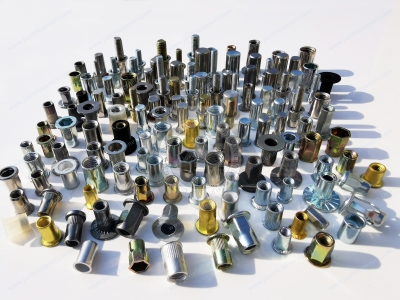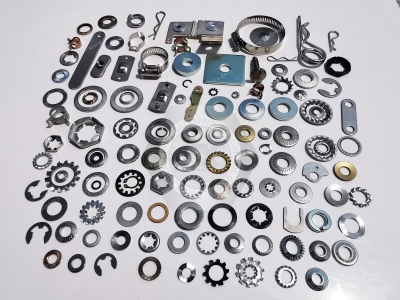Call Us
+86 136 6007 9809
Call Us
+86 136 6007 9809
Nov. 02, 2023
Fasteners are industrial parts that fasten and connect different parts into a whole and are widely used in the automotive industry. Although there are more varieties and specifications, the performance and use are other, and the degree of standardization, serialization, and generalization is also higher; fasteners are two or more parts (or components) tightly connected to become the whole of a class of mechanical parts used in the general term, also known as standard parts. Generally speaking, fasteners include nuts, screws, screws, bolts, studs, screws, clamps, retaining rings/washers, pins, flanges, rivets, plugs, pipe clamps, zip ties, snaps and so on. In the automotive industry market, automotive fasteners can be used in almost every sub-system, such as the engine, wheel suspension system, chassis system, airbags, automatic antilock braking system, braking system, door and body connections, chassis, and many other places. Some data show that the fasteners used in a car account for 40% of the total parts of the car; for example, in a light vehicle or a car, the average fasteners used in each car is about 580 kinds, 50 kg, and 5000 pieces. For a medium truck or a heavy-duty vehicle, the average number of fasteners needed per vehicle is 570 kinds, 90 kg, and 5710 pieces. In general, most of the fasteners we use belong to the type of general-purpose parts; its standard type is still relatively high; the common fastener parts are the following 12 kinds:
1. Washer: the shape of a flat ring-shaped class of fasteners. Placed on the bolt, screw, or nut support surface and connecting parts between the surfaces play a role in increasing the contact surface area of the connected parts, reducing the pressure per unit area, and protecting the surface of the connected part from being damaged; another type of elastic washers, but also play a role in preventing the nut back to the role of loose.
2. Retaining ring: For installation in the machine, equipment, shaft groove, or hole groove, it plays a role in preventing the shaft or hole on the parts of the left and right movement.
3. Pins are mainly used for part positioning; some can also be used for part connection, fixed parts, power transmission, or locking other fasteners.
4. Rivets: by the head and nail rod composed of two parts of a class of fasteners, used to fasten the connection of two through-hole parts (or components) to become a whole piece. This form of connection is called a riveted connection, referred to as riveting. Belongs to the non-removable connection. We must destroy the rivets on the parts to connect and separate the two parts.
5. The combination of parts and connection: combination of parts refers to a combination of a class of fasteners, such as a machine screw (or bolt, self-supporting screws) and flat washers (or spring washers, lock washers) combination of supply; connection refers to a combination of some special bolts, nuts and washers to a class of fasteners, such as steel structure with high-strength hexagonal bolts connected to the vice.
6. Welded nails: due to the light energy and nail head (or no nail head), it constitutes a different type of fastener, with the welding method to fix him connected to a part (or component) above, to then connect with other parts.


7. Bolt: by the head and screw (with external threads of the cylinder), two parts of a class of fasteners need to cooperate with the nut, used to fasten the connection of two parts with a through hole. This form of connection is called bolt connection. For example, the nut from the bolt spinning down can separate the two parts so the connection is removable.
8. Stud: there is no head, only the two ends of a class of fasteners with external threads. Connection, it must be screwed into one end with internally threaded holes in the parts, the other end through the parts with through holes, and then screwed on the nut, even if the two parts are tightly connected into a see whole. This connection is called a stud connection and belongs to the removable connection. Mainly used for one of the connected parts of greater thickness, requires a compact structure, or, due to frequent disassembly, should not be used in bolt connection occasions.
9. Nut: with internally threaded holes, the shape is generally shown as a flat hexagonal column, but also a flat square or flat cylindrical, with bolts, studs, or machine screws used to fasten the connection between the two parts so that it becomes a whole piece.
10. Wood screws: also similar to machine screws, but the threads on the screw for the particular wood screws with ribbing can be directly screwed into the wooden components (or parts), used to put metal (or non-metallic) parts through holes and rigid component fastening connection together. This connection also belongs to the removable connection.
11. Screws: also by the head and screw, two parts of a class of fasteners, according to the use, can be divided into three categories: machine screws, fastening screws, and special purpose screws. Machine screws are mainly used for fastening threaded holes in the parts. Through-hole parts with a fastening connection between the parts do not need to nut with (this form of connection is called screw connection and also belongs to the removable connection; it can also be used with the nut with the two through-hole parts with a fastening connection between the parts). Fastening screws are mainly used to fix the relative position between two parts. Special-purpose screws, such as ring screws for lifting parts.
12. Self-tapping screws: similar to the machine screws, but the thread on the screw for the particular self-tapping screw thread. Used to fasten the connection of two thin metal components so that it becomes a whole piece, components need to be made beforehand on the hole because this screw has a high hardness and can be directly screwed into the elements of the hole so that the elements in the formation of the response of the internal thread. This form of connection also belongs to the removable connection.
Fasteners change the energy emissions of the car in addition to changing the car itself and reducing pollution, improving efficiency, saving resources, putting quality ahead of the curve, keeping fasteners environmentally friendly, and ensuring long life in addition to the targeted start of lightweight processing. There are two standard light processing methods: the optimizer, ion of design, and alternative materials, such as sheet metal and integrated functional parts or plastic instead of the original metal. Fasteners processed through these two methods have already reached the lightweight standard, and some parts are even 50% lighter than before, which is only more intuitively perceivable!
If you are looking for high-quality automotive fastener screws & all kinds of plastic fasteners or technical support for structural design, please get in touch with me. Use our new Product Finder tool, download our Product Catalog, and let us help you get custom parts.adelajonly@gmail.com. Thanks. Website: www.juxinfasteners.com
Contact Us
Tel.:
+86 020 8621 0320
+86 020 3121 6067
Technical Support:
Navigation
SEND INQUIREY